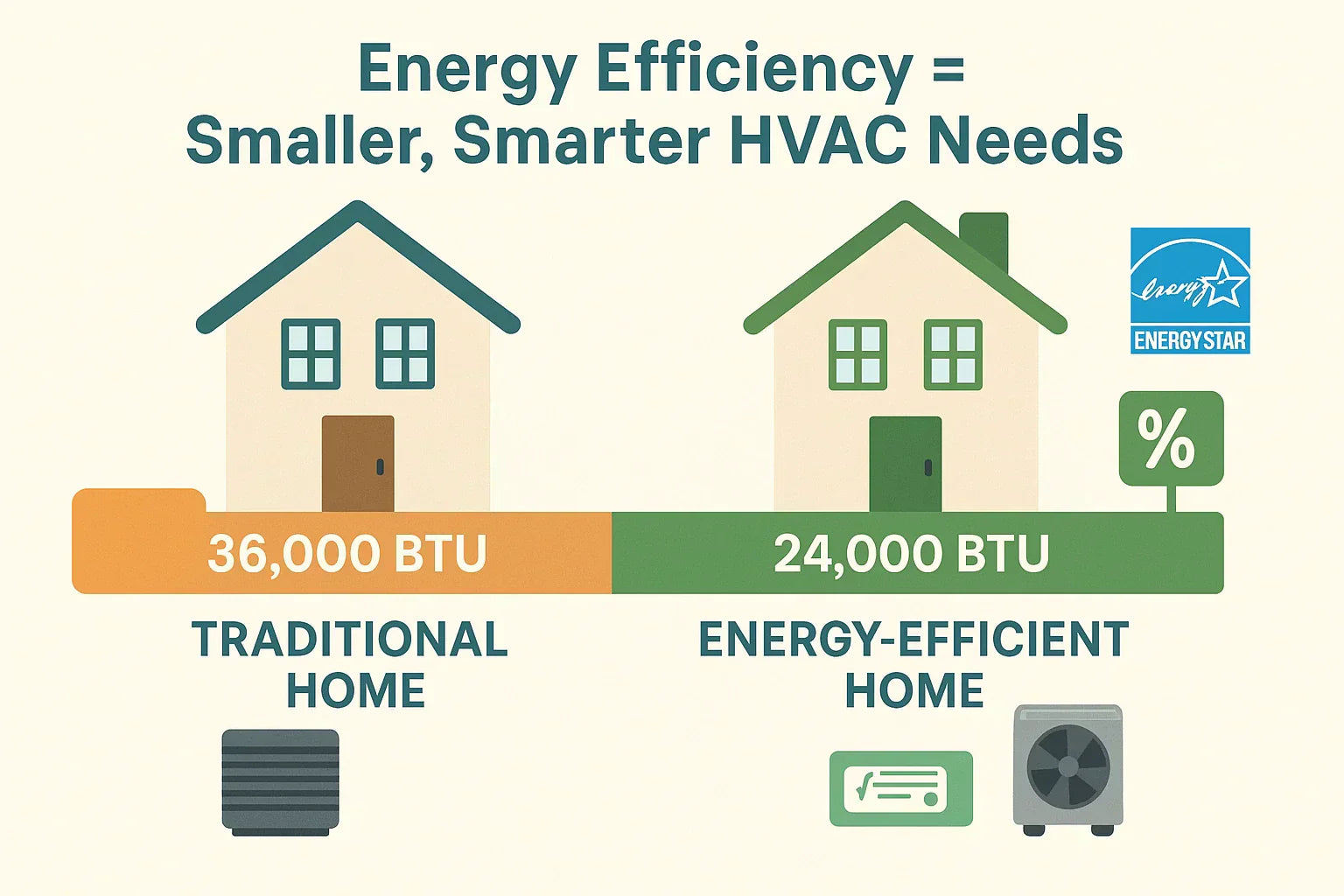Hi, I’m Alex Lane — your Home Comfort Advocate. Over the years, I’ve helped countless homeowners upgrade to more energy-efficient homes. But here’s something many folks don’t realize: when you tighten up your home’s envelope, your HVAC sizing needs change. And if you don’t adjust your equipment to match, you could end up with poor comfort, wasted energy, and even indoor air quality issues.
In this guide, we’ll look at why HVAC sizing becomes more critical—not less—in high-efficiency homes, and what to do to get it right.
✅ Want the full breakdown of HVAC sizing basics? Start with our How to Size an HVAC System for Your Home guide to see how home features like insulation, orientation, and ductwork factor in.
Energy-Efficient Homes Have Smaller Heating and Cooling Loads
🧱 More Insulation, Better Windows, Less Air Leakage
Modern energy-efficient homes are built (or retrofitted) to hold onto conditioned air longer. That means less heating in the winter, less cooling in the summer, and a lower overall BTU load.
If you’ve upgraded insulation, sealed air leaks, or installed high-performance windows, your HVAC system won’t have to work as hard—or be as big.
According to the U.S. Department of Energy, every part of your home interacts as a system. When you improve one area, it affects others—especially heating and cooling.
📉 Smaller Load = Smaller Equipment
That old 3.5-ton system your house used to need? After insulation upgrades, it might only require 2.5 tons. And oversizing your system "just to be safe" will backfire fast. Smaller, more efficient homes don’t benefit from oversized equipment—they suffer from it.
What Happens When You Oversize in a Tight, Efficient Home
🔁 Short Cycling Becomes a Real Problem
In an efficient home, an oversized HVAC system cools or heats the air too quickly and shuts off before it can do the second most important job: remove moisture.
This “short cycling” causes humidity to linger, leading to clammy indoor air, mold risk, and inconsistent comfort. Carrier explains how short cycling also increases wear and tear on your system.
💨 Poor Indoor Air Quality and Less Comfort
Airtight homes trap moisture and pollutants more easily. If your system doesn’t run long enough—or doesn’t cycle properly—it won’t filter the air effectively. That can lead to stale air, lingering odors, or humidity spikes.
But Undersizing Still Isn’t the Answer
🌡️ Low-Load Homes Still Need Proper Distribution
Even in a tight envelope home, an undersized system can struggle to distribute air evenly. You might end up with cold upstairs bedrooms or hot zones near sun-facing windows. Zoning or variable-speed systems can help, but you still need to know your actual load.
This is especially important for heat pumps in energy-efficient homes. While many models are designed for lower loads, they still need to be matched carefully to the space—especially in cold climates.
Precision Matters More in Low-Load Homes
📏 Manual J Calculations Are Essential
In energy-efficient homes, your margin for error gets smaller. A 10–15% sizing error can mean the difference between ideal comfort and constant frustration.
Manual J is the only way to account for your home’s actual performance. It measures:
-
Room-by-room loads
-
Solar gain through windows
-
Infiltration rates
-
Ventilation, duct losses, and more
🧠 Smarter Systems May Be Needed
High-efficiency homes often benefit from:
-
Zoned HVAC systems to fine-tune comfort
-
Multi-stage equipment for better part-load performance
-
Smaller-capacity, variable-speed units that run longer at lower speeds
The Building America Solution Center highlights how zoning can drastically improve performance in high-efficiency designs.
Best Practices for Sizing HVAC in Energy-Efficient Homes
❌ Don’t Just Replace What You Had
Many homeowners assume their new system should match the size of the old one. But if your home’s insulation, windows, or air sealing has improved—even a little—your load may have changed.
The Whole Building Design Guide stresses that a high-performance HVAC design begins with accurate load assessments and system selection based on efficiency—not legacy sizing.
✅ Work With a Pro Who Understands Modern Sizing
Not every contractor takes the time to do Manual J, or to match HVAC systems to newer construction methods. Look for ACCA-certified professionals or those who offer third-party energy audits. You can start your search with the ACCA Contractor Directory.
Final Thoughts
Energy-efficient homes are designed to work smarter—not harder. But that only works if your HVAC system is sized to match. In fact, the better your insulation, windows, and sealing, the more precision your HVAC system needs.
Oversizing leads to short cycling, humidity issues, and higher costs. Undersizing can leave parts of your home uncomfortable. The best solution? A system that’s properly sized based on a full Manual J calculation—and potentially zoned or variable-speed to fit your upgraded space.
🔁 Next: Wrap around to our first post in the series — Common HVAC Sizing Mistakes and How to Avoid Them
Alex Lane
Your Home Comfort Advocate







